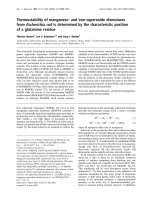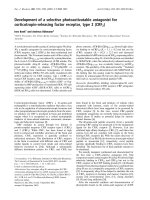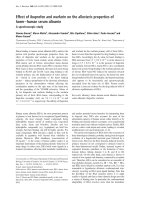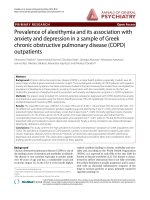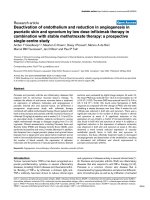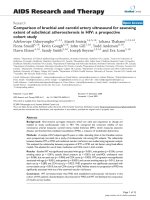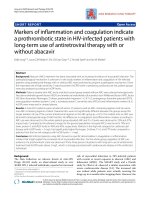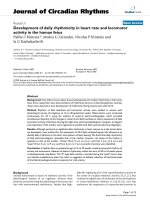Báo cáo y học: "Development of a theory of implementation and integration: Normalization Process Theory" ppsx
Bạn đang xem bản rút gọn của tài liệu. Xem và tải ngay bản đầy đủ của tài liệu tại đây (494.75 KB, 9 trang )
BioMed Central
Page 1 of 9
(page number not for citation purposes)
Implementation Science
Open Access
Research article
Development of a theory of implementation and integration:
Normalization Process Theory
Carl R May*
1
, Frances Mair
2
, Tracy Finch
1
, Anne MacFarlane
3
,
Christopher Dowrick
4
, Shaun Treweek
5
, Tim Rapley
1
, Luciana Ballini
6
,
Bie Nio Ong
7
, Anne Rogers
8
, Elizabeth Murray
9
, Glyn Elwyn
10
,
France Légaré
11
, Jane Gunn
12
and Victor M Montori
13
Address:
1
Institute of Health and Society, Newcastle University, Newcastle, UK,
2
Division of General Practice, Glasgow University, Glasgow, UK,
3
Department of General Practice, National University of Ireland, Galway, Ireland,
4
School of Population and Behavioural Sciences, University of
Liverpool, Liverpool, UK,
5
Centre for Primary Care and Population Research, University of Dundee, Dundee, UK,
6
Agenzia Sanitaria e Sociale
Regionale, Bologna, Italy,
7
Arthritis Research Campaign National Primary Care Centre, Keele University, Keele, UK,
8
National Primary Care
Research and Development Centre, University of Manchester, Manchester, UK,
9
Department of Primary Care, University College London, London,
UK,
10
Department of Primary Care and Public Health, School of Medicine, Cardiff University, Cardiff, UK,
11
Department of Family Medicine,
Université Laval, Québec, Québec, Canada,
12
Department of General Practice, University of Melbourne, Melbourne, Australia and
13
Knowledge
and Encounter Research Unit, Mayo Clinic, Rochester MN, USA
Email: Carl R May* - ; Frances Mair - ; Tracy Finch - ;
Anne MacFarlane - ; Christopher Dowrick - ; Shaun Treweek - ;
Tim Rapley - ; Luciana Ballini - ; Bie Nio Ong - ;
Anne Rogers - ; Elizabeth Murray - ; Glyn Elwyn - ;
France Légaré - ; Jane Gunn - ; Victor M Montori -
* Corresponding author
Abstract
Background: Theories are important tools in the social and natural sciences. The methods by which they
are derived are rarely described and discussed. Normalization Process Theory explains how new
technologies, ways of acting, and ways of working become routinely embedded in everyday practice, and
has applications in the study of implementation processes. This paper describes the process by which it
was built.
Methods: Between 1998 and 2008, we developed a theory. We derived a set of empirical generalizations
from analysis of data collected in qualitative studies of healthcare work and organization. We developed
an applied theoretical model through analysis of empirical generalizations. Finally, we built a formal theory
through a process of extension and implication analysis of the applied theoretical model.
Results: Each phase of theory development showed that the constructs of the theory did not conflict with
each other, had explanatory power, and possessed sufficient robustness for formal testing. As the theory
developed, its scope expanded from a set of observed regularities in data with procedural explanations,
to an applied theoretical model, to a formal middle-range theory.
Conclusion: Normalization Process Theory has been developed through procedures that were properly
sceptical and critical, and which were opened to review at each stage of development. The theory has been
shown to merit formal testing.
Published: 21 May 2009
Implementation Science 2009, 4:29 doi:10.1186/1748-5908-4-29
Received: 12 December 2008
Accepted: 21 May 2009
This article is available from: />© 2009 May et al; licensee BioMed Central Ltd.
This is an Open Access article distributed under the terms of the Creative Commons Attribution License ( />),
which permits unrestricted use, distribution, and reproduction in any medium, provided the original work is properly cited.
Implementation Science 2009, 4:29 />Page 2 of 9
(page number not for citation purposes)
Background
Theories are important for the social and natural sciences
because they make possible robust explanations of previ-
ously or currently observed phenomena, and because they
are points of departure for forecasts about future phenom-
ena. There are now a number of important and useful the-
ories of individual and group behaviour that can be
applied to understanding implementation problems [1-
4], and this paper described the processes by which one of
them – Normalization Process Theory (or NPT) [5-7] –
was developed between 2000 and 2009. The paper is an
account of the development of NPT. The objective of this
paper is to describe the procedures by which the theory
was built. We show how these procedures led to a set of
propositions that possessed sufficient face validity and
conceptual robustness to warrant formal testing. That
work is currently underway and its results will be reported
in due course
What is NPT?
NPT provides a set of sociological tools to understand and
explain the social processes through which new or modi-
fied practices of thinking, enacting, and organizing work
are operationalized in healthcare and other institutional
settings. In particular, the theory is concerned with three
core problems:
1. Implementation, by which we mean the social organi-
zation of bringing a practice or practices into action.
2. Embedding, by which we mean the processes through
which a practice or practices become, (or do not become),
routinely incorporated in everyday work of individuals
and groups.
3. Integration, by which we mean the processes by which
a practice or practices are reproduced and sustained
among the social matrices of an organization or institu-
tion.
The theory is described in detail elsewhere [5-7]. In sum-
mary, however, it is postulated that:
1. Practices become routinely embedded – or normalized
– in social contexts as the result of people working, indi-
vidually and collectively, to enact them.
2. The work of enacting a practice is promoted or inhib-
ited through the operation of generative mechanisms
(coherence, cognitive participation, collective action,
reflexive monitoring) through which human agency is
expressed.
3. The production and reproduction of a practice requires
continuous investment by agents in ensembles of action
that are carried forward in time and space.
The starting point of the theory is that to understand the
embedding of a practice we must look at what people
actually do and how they work. It is a theory of action.
This distinguishes it from theories of the cultural trans-
mission of innovations (such as Diffusion of Innovations
Theory [8,9]) that seek to explain how innovations
spread; theories of collective and individual learning and
expertise [10] that seek to explain how innovations are
internalized; and theories of the relationships between
individual attitudes and intentions and behavioural out-
comes [11]. The explanatory focus of the theory, and its
emphasis on human agency, sets it apart from sociological
theories of actor-networks [12] that take ethnographic
case studies at their primary method [13], wrongly
attribute agency to things as well as people, and explicitly
reject explanation in favour of description [11]. In con-
trast to the latter, the aim here has been to build a set of
sociological tools to investigate social shaping as action,
and to do this in a form that permits structured compara-
tive inquiry prospectively using a variety of methods.
Why was NPT developed?
The contingent and complex relational processes involved
in theory building are not the focus of this paper. But it is
important to address the question of why NPT came
about. The key problem it was developed to address was
the observed difficulty of implementing and integrating
new treatment modalities and ways of organizing care in
health service settings. Specifically, some of us sought to
address a perceived gap in the tools available to explain
the failure of apparently widely adopted and diffused tele-
medicine systems to become routinely incorporated in
clinical settings, even in circumstances where profession-
als were favourably disposed to them, and where signifi-
cant material political support was committed to them
[14]. Reviews of relevant theory published at that time [1-
4] explicated these explanatory gaps. Indeed, these
reviews seem to have been inspired by the recognition of
the lack of strong theoretical basis for the planning and
evaluating of implementation programmes. They reflect
calls for the use of theories to generate testable hypotheses
linking tailored strategies with factors that promote or
inhibit implementation, and various attempts to identify
theories or constructs within theories best suited for suc-
cessful implementation [15]. The development of NPT is
one response to these calls, and has the added value of
being derived from empirical generalizations developed
within studies of implementation and integration proc-
esses, rather than being derived from plausibly useful con-
structs embedded in other theories.
Procedural accounts of theory-building risk imposing an
artificial order on processes that are highly contingent.
Such processes are, in practice, very difficult to map. In
this instance, the social relations and processes that have
led to the development of NPT are complex, as are the
Implementation Science 2009, 4:29 />Page 3 of 9
(page number not for citation purposes)
research and policy problems and networks in which they
are located. However, we can say that the processes of the-
oretical development described in this paper were oppor-
tunistic and organic in the beginning. However, after a
formal Normalization Process Model [7] was developed
and presented at seminars and conferences during 2005
and 2006, a multi-disciplinary group of researchers
formed around the model and began to refine and
develop it – and, most importantly, to apply it to specific
research problems. After this group formed, theoretical
development was undertaken more deliberately and stra-
tegically, with formal meetings in 2007 and 2008. After
2008, development of NPT was support by funding for
meetings of a Peer Learning Set from the UK National
Institute of Health Research, and by a 'follow-on' grant
from the UK Economic and Social Research Council.
Methods
Phase one: Developing empirical generalizations
Between 2001 and 2004, data collected in qualitative
studies of healthcare work and organization was subjected
to secondary analyses, and sets of empirical generaliza-
tions were derived from these. These related to four
domains of research: the normalization of telemedicine
systems [16,17]; professional-patient interaction and the
organization of healthcare work in chronic illness [18,19];
and the social production and operationalization of evi-
dence in the clinical encounter [20]. These treated 'nor-
malization' as the endpoint of an implementation process
in which some new technology came to be routinely
employed in service. The comparative synthetic methods
used to generate empirical generalizations about telemed-
icine implementation processes were then used to per-
form a similar analysis on data collected in the other
studies. The methods by which secondary analyses were
carried out have been described in detail elsewhere [7].
The empirical generalizations produced by these proc-
esses were general conclusions about regularities in the
data, and were framed as formal propositions. They are
given in Appendix 1. They did not in themselves make a
theory because they were specific to particular contexts
(i.e., although they were generalizations, they were not
necessarily generalizable), and were not linked together
by some account of causal relations, generative mecha-
nisms, or organizing principles. In other words, they were
observational rather than explanatory.
Phase two: Building an applied theoretical model
Between 2003 and 2007, using grounded theory-building
techniques [21,22], an applied theoretical model of nor-
malization processes – the Normalization Process Model,
or NPM, [7] – was derived from earlier empirical general-
izations across all four domains of study. This was framed
as a set of analytic propositions (see Appendix 2) that
were supported by rigorous data analysis. This aimed to
develop what Stinchcombe [23] has called an applied the-
oretical model of the factors that promote or inhibit the
work of routine embedding of some new health technol-
ogy in practice. These were first subject to critical review
from a large group of researchers to whom manuscripts of
different iterations of the model were informally circu-
lated, and discussed at a series of seminars.
The purpose of the NPM was to identify and explain those
factors that promoted or inhibited collective action that
led to the routine embedding of complex healthcare inter-
ventions in service settings. There were four of these
(interactional workability, relational integration, skill-set
workability, and contextual integration) and we defined
these as the constructs of the NPM. At this stage, the NPM
synthesized empirical generalizations from groups of
related studies, and producing taxonomies, maps of rela-
tions between concepts, and generalizations [24]. These
were linked together by sociological explanations of the
relations between its constructs, their dimensions, and
components. Taken together these set the scene for possi-
ble empirical verification.
Refining and testing the NPM
As an applied theoretical model, the NPM was restricted
to a specific field of activity: the operationalization of
complex healthcare interventions [7]. To develop it fur-
ther we sought to define and stabilise the way that we con-
ceptualized theory itself. We assigned to theory three
kinds of work [6]:
1. Accurate description: A theory must provide a taxon-
omy or set of definitions that enable the identification,
differentiation, and codification of the qualities and prop-
erties of cases and classes of phenomena.
2. Systematic explanation: A theory must provide an
explanation of the form and significance of the causal and
relational mechanisms at work in cases or classes of the
phenomena defined by the theory, and should propose
their relation to other phenomena.
3. Knowledge claims: A theory must lead to knowledge
claims. These may take the form of abstract explanations,
analytic propositions, or experimental hypotheses.
Further development of the NPM involved applying it
empirically, in a process of 'road testing' the theoretical
model [25]. An important critique of theory building is
that it is sometimes precipitate, proceeding before the
generalizability of the phenomena it is concerned with is
properly established [26]. A second critique is that theory-
builders focus too early on the problem of defining and
measuring variables supposed to be relevant, without suf-
Implementation Science 2009, 4:29 />Page 4 of 9
(page number not for citation purposes)
ficient consideration of the coherence and robustness of
basic concepts and constructs of the theory itself [27].
'Road testing' the NPM enabled us to work through these
problems and provided a context in which to make
rational decisions about face validity, and to ask whether
the NPM merited formal testing. This consisted of two
main pieces of work, quantitative data analysis and
research synthesis.
Qualitative data analysis
We integrated the NPM in qualitative data analysis in
three large studies (of the implementation of e-health
technologies [28], the integration of telecare systems
[29,30], and the operationalization of a large randomized
controlled trial). As we did this, we sceptically sought evi-
dence for the adequacy of the NPM to perform the three
functions of theory that we had previously claimed for it
– to define phenomena, explain mechanisms, and form
knowledge claims. It is important to be clear that this was
not formal testing, because we did not at this stage seek to
falsify the NPM. Instead, we practically tested its useful-
ness as an analytic tool.
Research synthesis
Elwyn et al. [31] undertook a parallel critical analysis of
the NPM by applying it to the problems of operationaliz-
ing shared decision-making tools in medical consulta-
tions. Participants in that process mapped the constructs
of the NPM against data from evaluation and other litera-
ture, including primary studies and systematic reviews,
and produced a set of attributions about the conclusions
of these studies. The NPM was then applied to these attri-
butions to determine whether it usefully explained them.
Elwyn et al. [31] concluded that the NPM offered stable
explanations of the collective work involved in shared
decision-making processes and operationalizing decision-
making tools.
By the end of 2006, the NPM in its published form [7] was
sufficient as a set of conceptual tools to analyse specific
processes, and it has been successfully applied to this pur-
pose [32-36]. 'Road testing' showed that it had utility in
explaining factors that promoted and inhibited collective
action in operationalizing practices. It did not, however,
explain how practices were formed in ways that held
together, how actors were enrolled into them, or how they
were appraised. These were three domains in which NPM
could usefully be expanded. This recognition informed
the next stage of theory building.
Phase three: Making a formal theory
After 2006, we worked to solve these problems. Between
2006 and 2009, the applied theoretical model of the NPM
was extended, new constructs defined, and generative
mechanisms defined, so that it formed a formal middle-
range theory – NPT.
The production of a formal theory is a quite different
enterprise than the work that goes into the identification
of empirical generalizations or applied explanations. The
goal of theory-building at this level is to isolate the generic
properties of phenomena and understand their operation
[37]. To do this, we had to reformulate the healthcare-spe-
cific constructs of the NPM as generic or abstract proposi-
tions, and then to extend the theory by writing three
constructs that related to domains we had previously
established were absent. We called these coherence, cogni-
tive participation, and reflexive monitoring. Although at
this stage we still regarded our work as framing an
extended NPM, we had embarked on a process that would
lead to a generalizable, middle-range, formal theory:
1. We had defined NPM constructs as factors that pro-
moted or inhibited collective action leading to the routine
embedding of some intervention. We used additional
analyses to identify macro-level analogues of the con-
structs of the model [30,38]. These took the form shown
in Appendix 3. We then constructed full definitions of the
macro-level analogues of the NPM constructs and tested
them against already collected data.
2. We operationalized macro-level constructs in a way that
mapped on to the existing constructs of the NPM (see
Appendix 4). For example, we construed collective action
as a macro-level construct (with micro-level constructs of
interactional workability, relational integration, skill-set
workability, and contextual integration).
3. As we worked through macro-level constructs, we also
began to use a much more structured model of theory-
building in which generative mechanisms and relations
required definition [39,40]. In this context, we shifted
attention to coherence work not as a macro-level abstrac-
tion of contextual integration, but rather as a generative
mechanism through which an intervention was subjected
to sense-making procedures by its users.
4. We drew maps of the processes with which we were
concerned. This method for identifying the constituents
of conceptual models is called analytical theorizing by
Turner [37]. This led to a map of the expanded NPM at
work. We then followed Lieberson and Lynn [40] in
reframing macro-level constructs derived from the NPM
as descriptors of 'generative principles'.
The extended NPM that was derived from this work now
had a general character, and the generative mechanisms
and components to which it referred were not exclusive to
Implementation Science 2009, 4:29 />Page 5 of 9
(page number not for citation purposes)
complex interventions or even healthcare. They referred
instead to generic properties of implementation processes
and offered an explanation of them without reference to
specific social contexts. We therefore presented it as a gen-
eral, and generalizable, middle-range theory, NPT [5,41]),
that seeks to explain the processes of implementation,
embedding, and integration of material practices in for-
mally defined contexts, relates these processes to causal
social mechanisms [42], identifies components of those
mechanisms, and defines the investments that are
required to energize them. The mechanisms of the NPT
are described in detail elsewhere [5], but synopses are pro-
vided in Appendix 4 and Appendix 5.
Road testing the NPT
Just as development of the NPM involved a process of
'road testing' to decide whether it was sufficiently plausi-
ble and robust to merit formal testing, so did the NPT. We
accomplished this using multiple methods. It is important
to emphasise that the purpose of this work was not to for-
mally test the theory, but rather to demonstrate that it was
fit to be tested:
1. Assessing the stability of NPT constructs: Researchers
working in very different contexts and on very different
studies (including studies of e-health implementation
and reconfiguration of primary care mental health serv-
ices in the State of Victoria, Australia) worked with the
constructs of the NPT to develop analyses of implementa-
tion and embedding processes [43,44]. The criteria for sta-
bility were that the generic constructs could be translated
into specific contexts without the addition of ad hoc con-
ditions, and that sceptical researchers were able to use
them in practice with minimal support.
2. Critical comparison of NPM and NPT constructs: A key
question was whether or not expanding the scope of nor-
malization process analysis to the higher-level constructs
of the NPT has practical value. In other words, we wanted
to be clear that there was an advantage to using the NPT.
To this end, we coded two sets of data (interview tran-
scripts from a study of e-health implementation proc-
esses, and qualitative data collected in systematic review
of e-health implementation studies) using both the NPM
and NPT [43].
To summarise, 'road testing' NPT required that we estab-
lish that its constructs actually defined mechanisms, com-
ponents, and investments that could all be prospectively
revealed by empirical research, and that these could be
characterised in a stable way. We then had to demonstrate
that these constructs could be operationalized in a way
that conferred an analytic advantage. We sought confi-
dence that NPT covered the ground we claimed for it, and
that propositions could be derived from it that could
effectively test the data and explain phenomena. This
process was important because it paralleled the final revi-
sions of the NPT as subsequently accepted for publication.
Relationship between the NPM and NPT
The formal theory (NPT) does not conflict with the
applied model (NPM) from which it was drawn. In fact, it
extends it. The constructs of the NPM are central to the
formal theory and constitute its collective action compo-
nent. The NPM is unchanged by this, and researchers can
continue to successfully use the NPM in settings where
only those factors that promoted or inhibited collective
action are at issue [32-35,45,46]. The NPT, however,
extends the applied theoretical model to include the ways
by which actors make sense of a set of practices (coher-
ence), the means by which they participate in them (cog-
nitive participation), and the forms of appraisal that they
apply (reflexive monitoring)
NPT is a middle-range theory
Although it has been developed through a series of multi-
disciplinary collaborations, NPT is a sociological theory in
that it takes as its focus the contribution of social action to
implementation, embedding, and integration. It is also a
middle-range theory [47,48]. Following Merton [49]), we
use this term to mean the following: the theory is 'suffi-
ciently abstract to be applied to different spheres of social
behaviour and structure' but does not offer a set of general
laws about behaviour and structure at a societal level; the
scope of the theory is defined by a limited set of assump-
tions from which can be derived hypotheses that may be
confirmed or disconfirmed by empirical investigation; the
limited scope of the theory leads to the 'specification of
ignorance'. That is, the limits of explanation within the
frame of the theory are established, and it does not 'pre-
tend to knowledge where it is in fact absent'.
Specifying the range of the theory is important. Recent
debates about theory in the social sciences [13,50,51]
have emphasised the search for 'medium-scope patterns
and mechanisms [that] distinguish between a complex
social reality and an intentionally simplified analytical
model of this reality' [50]. The limited scope, conceptual
range, and claims of middle-range theories are important
because they are what make them practically workable in
analysing practice.
Results
The changing scope of the theory
This paper has described the procedures by which NPT
was developed. The development of a set of explanatory
ideas around normalization has shifted from an initial set
of empirical generalizations presented as synthetic propo-
sitions or assertions [17], to a robust conceptual model
that presented generalizable propositions [7], and finally
Implementation Science 2009, 4:29 />Page 6 of 9
(page number not for citation purposes)
to a middle-range theory that offers a set of mechanism-
based explanations for processes of implementation,
embedding, and integration [5]. This has involved a
steady shift away from context dependent statements. The
processes of theory development described here have
included changes in scope, as well as method. Simply
accounting for this is unusual, but is a necessary precondi-
tion for research that subjects the NPT to formal and
definitive tests. It is important to show that the theory has
been derived through processes that have involved the
application of rigorous methods, that these methods have
been applied in a properly sceptical way, and that the out-
comes of their application have been critically assessed.
The importance of transparency
Despite different streams of writing about theory develop-
ment in the social sciences – for example, writing around
the construction of grounded theory [21,22,51-54], and
about the development of formal sociological theory
[23,54,55] – we actually have few factual accounts of the
development of theories themselves. When they exist,
these often take the form of personal histories [56], or
accounts of particular social networks [57]. So, although
there are many papers that seek to present some new the-
ory, we can often discover little about where they come
from or about the methods by which they were derived.
Unless there is already a large body of literature that
presents studies that have interrogated or tested a particu-
lar theory in play, we are then stuck with the problem of
how to evaluate its relation to the phenomena that it seeks
to explain. Such theories sometimes seem to spring fully-
formed from critiques of the literature, or by assertions
about prior theories. We have sought to avoid this prob-
lem.
Conclusion
The process of theory-building described in this paper has
led from secondary analysis of qualitative data through to
the development of a set of generic theoretical proposi-
tions that can be employed to explain implementation
and integration. Our aim in the work described in this
paper has been to develop an explanatory model that can
underpin structured, prospective studies that have both
practical and policy relevance, and which are genuinely
open to interdisciplinary inquiry. This theory-building
process has been a highly collaborative one, in which
many people have made very important contributions to
the development of theoretical explanation. None of
those who participated in the first stage of theory-building
described earlier in this paper recognised that they were
involved in a process that would, subsequently, need to be
accounted for in a paper such as this. At this stage, it is
therefore important to describe the procedures by which
the enterprise of theory building has been accomplished.
The theory itself is described in detail elsewhere [5], and
accounts of research that tests the theory, for good or ill,
are forthcoming.
Competing interests
The authors declare that they have no competing interests.
Authors' contributions
Authorship is ordered according to the time-point at
which contributors joined in the work of theory develop-
ment described in this paper, and their contributions are
attributed on the following basis. The programme of the-
ory-building was led by CRM. He also drafted this manu-
script (with substantial assistance from AMacF). Phase
one included CRM, FM, TF and AMacF; Phase two
included CRM, FM, TF, CFD, AMacF, ST, TR, BNO, AR,
EM, GE, and FL; in Phase three, formal theory develop-
ment was done by CRM and TF. Other contributions to
work in this phase were made by FL, FM, EM, JG, and VM.
All authors have contributed practically and intellectually
to the work that led to this paper and have commented
and agreed on the manuscript.
Appendix
Appendix 1 – Empirical generalizations on normalization
processes for telemedicine (2003) [17]
P
1
Implementation of telemedicine services depends
on a positive link with a (local or national) policy level
sponsor, so that telemedicine is defined as an appro-
priate means of delivering care, and appropriate infra-
structures are developed.
P
2
Adoption of telemedicine systems in service
depends on successful integration at the level of struc-
tural legitimation so that it is supported as, and thus
practically incorporated into, health care delivery
through the development of organizational structures.
P
3
Translation of telemedicine technologies into clini-
cal practice depends on the enrolment of heterogene-
ous actors into relatively cohesive, co-operative
groups, in which functional identities are negotiated
and established a priori and powers relatively well
defined.
P
4
Stabilization of telemedicine systems in practice
depends on integration at the level of professional
knowledge and practice, where clinicians are able to
accommodate telemedicine in their clinical activities
through the development of new procedures and pro-
tocols.
P
5
The normalisation of telemedicine as a means of
health care delivery (in whatever setting, and at what-
ever level of healthcare provision) is conditional on P
1
+ P
2
+ P
3
+ P
4
.
Implementation Science 2009, 4:29 />Page 7 of 9
(page number not for citation purposes)
Appendix 2 – Propositions of the Normalization Process
Model (2006) [7]
1. A complex intervention is disposed to normalization if
it confers an interactional advantage in flexibly accom-
plishing congruence and disposal;
2. A complex intervention is disposed to normalization if
it equals or improves accountability and confidence
within networks;
3. A complex intervention is disposed to normalization if
it is calibrated to an agreed skill-set at a recognizable loca-
tion in the division of labour;
4. A complex intervention is disposed to normalization if
it confers an advantage on an organization in flexibly exe-
cuting and realizing work.
Appendix 3 – Intermediate development of the theory –
macro to micro links between constructs [39]
Domain of work (macro level)
(Defined as generative mechanisms in Normalization
Process Theory)
Coherence: Work that defines and organizes the objects
of a practice.
Cognitive participation: Work that defines and organizes
the enrolment of participants in a practice.
Collective action: Work that defines and organizes the
enacting of a practice.
Reflexive monitoring: Work that defines and organizes
the knowledge upon which appraisal of a practice is
founded.
Everyday practices (micro level)
(Defined as constructs of the Normalization Process
Model)
Practices that ensure contextual integration with health-
care systems and services
Practices that are defined by their skill-set workability
within formal and informal divisions of healthcare labor.
Practices that are defined by their interactional workabil-
ity within a set of everyday social relations.
Practices that ensure relational integration of knowledge
and practice in a network of actors
Appendix 4 – General Propositions of Normalization
Process Theory (2009) [5]
1. Material practices become routinely embedded in
social contexts as the result of people working, indi-
vidually and collectively, to implement them. From
this follows specific propositions that assert that
define a mechanism (i.e., embedding is dependent on
socially patterned implementation work).
2. The work of implementation is operationalized
through four generative mechanisms (coherence, cog-
nitive participation, collective action, reflexive moni-
toring). From this follows specific propositions that
define components of a mechanism (i.e., those factors
that shape socially patterned implementation work).
3. The production and reproduction of a material
practice requires continuous investment by agents in
ensembles of action that carry forward in time and
space. From this follows specific propositions that
define actors' investments in a mechanism (i.e., how
the mechanism is energized).
Appendix 5 – Specific propositions of Normalization
Process Theory (2009) [5]
Coherence
Routine embedding is dependent on work that defines
and organizes a practice as a cognitive and behavioural
ensemble.
Embedding work is shaped by factors that promote or
inhibit actors' apprehension of a practice as meaning-
ful.
The production and reproduction of coherence in a
practice requires that actors collectively invest mean-
ing in it.
Cognitive participation
Routine embedding is dependent on work that defines
and organizes the actors implicated in a practice.
Embedding work is shaped by factors that promote or
inhibit actors' participation.
The production and reproduction of a practice
requires that actors collectively invest commitment in
it.
Collective action
Routine embedding is dependent on work that defines
and operationalizes a practice.
Implementation Science 2009, 4:29 />Page 8 of 9
(page number not for citation purposes)
Embedding work is shaped by factors that promote or
inhibit actors' enacting it.
The production and reproduction of a practice
requires that actors collectively invest effort in it.
Reflexive monitoring
Routine embedding is dependent on work that defines
and organizes the everyday understanding of a prac-
tice.
Embedding work is shaped by factors that promote or
inhibit appraisal.
The production and reproduction of a practice
requires that actors collectively invest in its under-
standing.
Acknowledgements
Preparatory work for this paper was made possible by the award of a grant
to EM and CRM of National Institutes for Health Research funding for a
National School of Primary Care Research Peer Learning Set on the devel-
opment of NPT. This group met in Edinburgh, Scotland, on 5 and 6 October
2008. Views presented in this paper are those of the authors and not of the
UK Department of Health. We thank Dr Emma Fossey (Her Majesty's
Inspectorate of Constabulary for Scotland), Catherine O'Donnell, Cather-
ine Pope, Anne Kennedy, Stephanie Tooth, and Rob Wilson for their con-
tributions to this meeting.
References
1. Ashford AJ: Behavioural change in professional practice: supporting the
development of effective implementation strategies Newcastle upon
Tyne: Centre for Health Services Research; 2002.
2. Wensing M, Bosch M, Foy R, Weijden T van der, Eccles M, Grol R:
Factors in theories on behaviour change to guide implementation and qual-
ity improvement in healthcare Nijmegen: University of Nijmegen; 2005.
3. Grol R, Wensing M, Hulscher M, Eccles M: Theories on implementation
of change in healthcare Nijmegan: WOK; 2004.
4. Grol RP, Bosch M, Hulscher M, Eccles M, Wensing M: Planning and
studying improvement in patient care: the use of theoretical
perspectives. Milbank Quarterly 2007, 85(1):93-138.
5. May C, Finch T: Implementation, embedding, and integration:
an outline of Normalization Process Theory. Sociology 2009 in
press.
6. May C, Finch T, Mair F, Ballini L, Dowrick C, Eccles M, Gask L, Mac-
Farlane A, Murray E, Rapley T, et al.: Understanding the imple-
mentation of complex interventions in health care: the
normalization process model. BMC Health Serv Res 2007, 7:142.
7. May C: A rational model for assessing and evaluating complex
interventions in health care. BMC Health Serv Res 2006, 6:86.
8. Coleman JS, Katz E, Menzel H: Medical innovation: a diffusion study Indi-
anapolis: Bobbs-Merrill; 1966.
9. Rogers EM: The Diffusion of Innovations 4th edition. New York: Free
Press; 1995.
10. Wenger E: Communities of practice: learning, meaning and identity Cam-
bridge: Cambridge University Press; 1998.
11. Ajzen I, Fishbein M: Understanding Attitudes and Predicting Social Behav-
iour Englewood Cliffs, NJ, Prentice-Hall; 1980.
12. Latour B: Reassembling the Social: An Introduction to Actor Network The-
ory Oxford: Oxford University Press; 2005.
13. Geels FW: Feelings of discontent and the promise of middle
range theoy for STS: examples from technology dynamics.
Sci Tech Hum Values 2007, 32(3):627-651.
14. May C, Mort M, Mair F, Ellis NT, Gask L: Evaluation of new tech-
nologies in health care systems: what's the context? Health
Informat J 2000, 6:64-68.
15. Michie S, Johnston M, Abraham C, Lawton R, Parker D, Walker A:
Making psychological theory useful for implementing evi-
dence based practice: a consensus approach. Qual Saf Health
Care 2005, 14(1):26-33.
16. May C, Mort M, Williams T, Mair FS, Gask L:
Health Technology
Assessment in its local contexts: studies of tele-healthcare.
Soc Sci Med 2003, 57:697-710.
17. May CR, Harrison R, Finch T, MacFarlane A, Mair FS, Wallace P:
Understanding the normalization of telemedicine services
through qualitative evaluation. J Am Med Informat Ass 2003,
10(6):596-604.
18. May C, Allison G, Chapple A, Chew-Graham C, Dixon C, Gask L,
Graham R, Rogers A, Roland M: Framing the doctor-patient
relationship in chronic illness: a comparative study of gen-
eral practitioners' accounts. Sociol Health Ill 2004, 26(2):135-158.
19. May C: Chronic illness and intractability: professional-patient
interactions in primary care. Chronic Illn 2005, 1(1):15-20.
20. May C, Rapley T, Moreira T, Finch T, Heaven B: Technogovern-
ance: Evidence, subjectivity, and the clinical encounter in pri-
mary care medicine. Soc Sci Med 2006, 62(4):1022-1030.
21. Glaser BG, Strauss A: The discovery of grounded theory Chicago: Aldine;
1967.
22. Strauss A: Qualitative analysis for social scientists Cambridge: Cambridge
University Press; 1987.
23. Stinchcombe A: Constructing social theories New York: Harcourt, Brace
and World; 1968.
24. Dixon-Woods M, Agarwal S, Jones D, Young B, Sutton A: Synthesis-
ing qualitative and quantitative evidence in reviews: a review
of methods. J Hlth Serv Res Pol 2005, 10:45-53.
25. May C: Mobilizing modern facts: Health Technology Assess-
ment and the politics of evidence. Sociology of Health & Illness
2006, 28(5):513-532.
26. Goldthorpe JH: On Sociology: Critique and Program Stanford: Stanford
University Press; 2006.
27. Wacker JG: A theory of formal conceptual definitions: devel-
oping theory-building measurement instruments. J Operations
Management 2004, 22(6):629-650.
28. Mair FS, May C, Finch T, Murray E, Anderson G, Sullivan F, O'Donnell
C, Wallace P, Epstein O: Understanding the implementation
and integration of e-health services. J Telemed Telecare 2007,
13:S36-S37.
29. Finch TL, Mort M, Mair FS, May CR: Tele-healthcare and future
patients: Configuring 'the patient'. Hlth Soc Care Comm 2007,
16(1):86-95.
30. May C: Innovation and Implementation in Health Technol-
ogy: Normalizing Telemedicine. In The New Sociology of the
National Health Service Edited by: Gabe J, Calnan M. London:
Routledge.
31. Elwyn G, Legare F, Edwards A, Weijden T van der, May C: Arduous
implementation: does the normalisation process model
explain why it is so difficult to embed decision support tech-
nologies in routine clinical practice. Implementation Science
2008, 3:57.
32. Morriss R: Implementing clinical guidelines for bipolar disor-
der. Psychology and Psychotherapy-Theory Research and Practice 2008,
81:437-458.
33. Gask L, Rogers A, Campbell S, Sheaff R: Beyond the limits of clin-
ical governance: the case of mental health in primary care.
BMC Health Serv Res 2008, 8:63.
34. King G, Richards H, Godden D: Adoption of telemedicine in
Scottish remote and rural general practices: a qualitative
study. J Teleme Telecare 2007, 13(8):382-386.
35. Mair FS, Hiscock J, Beaton SC: Understanding factors that inhibit
or promote the utilization of telecare in chronic lung dis-
ease. Chronic Ill 2008, 4(2):110-117.
36. Finch TL, Mair FS, May CR: Teledermatology in the UK: lessons
in service innovation. Brit J Dermatol 2007, 156(3):521-527.
37. Turner JH: Analytical Theorizing. In Social Theory Today Edited by:
Giddens A, Turner J. Cambridge: Polity Press; 1987:156-194.
38. Finch T: Teledermatology for chronic disease management:
coherence and normalization. Chronic Ill 2008, 4(2):127-134.
39. Hechter M, Horne C: Theory is explanation. In Theories of social
order Edited by: Hechter M, Horne C. Stanford CA: Stanford Univer-
sity Press; 2003.
Publish with BioMed Central and every
scientist can read your work free of charge
"BioMed Central will be the most significant development for
disseminating the results of biomedical research in our lifetime."
Sir Paul Nurse, Cancer Research UK
Your research papers will be:
available free of charge to the entire biomedical community
peer reviewed and published immediately upon acceptance
cited in PubMed and archived on PubMed Central
yours — you keep the copyright
Submit your manuscript here:
/>BioMedcentral
Implementation Science 2009, 4:29 />Page 9 of 9
(page number not for citation purposes)
40. Lieberson S, Lynn FB: Barking up the wrong branch: Scientific
alternatives to the current model of sociological science.
Annual Review of Sociology 2002, 28:1-19.
41. May C: Mundane Medicine, Therapeutic Relationships, and
the Clinical Encounter.'. In Handbook of the Sociology of Health, Ill-
ness, and Healing: A Blueprint for the 21st Century Edited by: Pescosolido
B, Martin JA, Rogers A. New York: Springer.
42. Hedstrom P: Dissecting the Social: On the Principles of Analytical Sociology
Cambridge: Cambridge University Press; 2005.
43. Mair F, May C, Murray E, Finch T, Anderson G, O'Donnell C, Wallace
P, Sullivan F: Understanding the Implementation and Integration of E-
Health Services London: National Co-ordinating Centre for the
National Institute for Health Research Service Delivery and Organi-
sation Programme (NCCSDO); 2009.
44. Gunn J, Kokanovic R, Palmer V, Potiriadis M, Johnson C, Johnston
Ata-Ata K, Dowrick C, Griffiths F, Hegarty K, Herrman H, et al.: Re-
organising the care of depression and other related disorders in the Austral-
ian Primary Health Care Setting Canberra: Australian Primary Health
Care Research Institute; 2009.
45. May C, Mair FS, Dowrick C, Finch T: Process evaluation of com-
plex interventions in primary care: understanding trials
using the normalization process model. BMC Fam Pract 2007,
8:42.
46. Wilkes S: Evaluation of open access hysterosalpingography in
the initial management of infertility in primary care. Unpub-
lished PhD Thesis, University of Sunderland; 2007.
47. Merton R: Social Theory and Social Structure New York: Free Press;
1968.
48. Boudon R: What middle-range theories are. Contemp Sociol
1991, 20(4):519-522.
49. Merton RK: On Theoretical Sociology: five essays, old and new New York:
The Free Press; 1967.
50. Hedstrom P, Swedberg R: Introduction. In Social Mechanisms: An
Analytical Approach to Social theory Edited by: Hedstrom P, Swedberg
R. Cambridge: Cambridge University Press; 1998:1-26.
51. Glaser BG: The future of grounded theory. Qual Health Res 1999,
9(6):836-845.
52. Strauss A, Corbin J: Basics of Qualitative Research. Techniques and Pro-
cedures for Developing Grounded Theory Thousand Oaks CA: Sage;
1998.
53. Charmaz K: Constructing Grounded Theory: A Practical Guide Through
Qualitative Analysis London: SAGE; 2006.
54. Land K: Formal theory. Sociol Methodol 1971,
3:175-220.
55. Jasso G: Principles of theoretical analysis. Sociol Theory 1988,
6:1-20.
56. Rogers EM: A prospective and retrospective look at the diffu-
sion model. J Health Communicat 2004, 9:13-19.
57. Collins HM: Tacit knowledge in scientific networks. In Science
in context: readings in the sociology of science Edited by: Barnes B, Edge
D. Buckingham: Open University Press; 1982:44-64.
